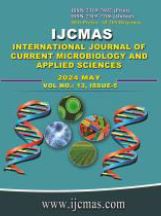


 National Academy of Agricultural Sciences (NAAS)
National Academy of Agricultural Sciences (NAAS)

|
PRINT ISSN : 2319-7692
Online ISSN : 2319-7706 Issues : 12 per year Publisher : Excellent Publishers Email : editorijcmas@gmail.com / submit@ijcmas.com Editor-in-chief: Dr.M.Prakash Index Copernicus ICV 2018: 95.39 NAAS RATING 2020: 5.38 |
Candida species have emerged as the most opportunistic pathogens to cause blood stream infections. To explore the usefulness of Chromogenic medium in speciating clinical isolates of Candida and to determine their antifungal susceptibility. A total of 80 Candida species were isolated from blood sample. Speciation of Candida was done based on the growth on Chromogenic medium and other methods like formation of Germ Tube Test. Among the 80 clinical Candida isolates, only 25% of the Candida isolates were identified as Candida albicans and the rest were non albicans Candida species. 22.5% Candida parapsilosis (18/80), 25% Candida krusei (20/80), 27.5% Candida tropicalis (22/80). Among the non albicans species Candida tropicalis was the commonest isolate followed by C.krusei and C. parapsilosis. CHROM Agar can be used for rapid identification of most commonly isolated Candida species from blood samples. This will be useful to initiate appropriate antifungal therapy thereby reducing morbidity and mortality.
Dharmeswari T et al., Use of chromogenic medium for speciation of candida isolated from clinical specimens. IJCRR. 2014; 6(1):1-5. https://doi.org/10.20546/ijcmas.2018.703.307.
Falagas M E, Apostolou K E, Pappas V D. Attributable mortality of candidemia: a systematic review of matched cohort and case-control studies. Eur J Clin Microbiol Infect Dis 2006; 25:419–425. https://doi.org/10.1007/s10096-006-0159-2 [PubMed: 16773391]
Gebremicael et al., Candida bloodstream infection among children hospitalised in three public-sector hospitals in the Metro West region of Cape Town, South Africa. BMC Infectious Diseases (2023) 23:67. https://doi.org/10.1186/s12879-023-08027-z
Hoppe, J. E. and P. Frey: Evaluation of six commercial tests and the germ tube test for the presumptive identification of Candida albicans. Eur. J. Clin. Microbiol. Infect. Dis.1999; 18:188-191. https://doi.org/10.1007/s100960050256
Krcmery V, Barnes A J. Non-albicans Candida spp. causing fungaemia: pathogenicity and antifungal resistance. J Hosp Infect 2002;50:243–260. https://doi.org/10.1053/jhin.2001.1151
Mine Yucesoy; Serhat Marol; Performance of CHRO Magar Candida and BIGGY agar for identification of yeast species; Annals of Clinical Microbiology and Antimicrobials 2003; 2:8 https://doi.org/10.1186/1476-0711-2-8
Nucci M, Silveira M I, Spector N, et al., Risk factors for death among cancer patients with fungemia. Clin Infect Dis 1998; 27:107–11. https://doi.org/10.1086/514609
Pallotta F et al., The Clinical Characteristics of Bloodstream Infections Due to Candida spp. in Patients Hospitalized in Intensive Care Units during the SARS-CoV-2 Pandemic: The Results of a Multicenter Study.J. Fungi 2023, 9, 642. https://doi.org/10.3390/jof9060642
Pappas P G, Rex J H, Lee J, et al., A prospective observational study of candidemia: epidemiology, therapy, and influences on mortality in hospitalized adult and pediatric patients. Clin Infect Dis 2003;37:634–643. https://doi.org/10.1086/376906
Pelz R K, Lipsett P A, Swoboda S M, et al., Candida infections: outcome and attributable ICU costs in critically ill patients. J Intensive Care Med 2000; 15:255–61. https://doi.org/10.1046/j.1525-1489.2000.00255.x
Reda N. M. et al., Prevalence and species distribution of Candida bloodstream infection in children and adults in two teaching university hospitals in Egypt: frst report of Candida kefyr. Infection (2023) 51:389–395. https://doi.org/10.1007/s15010-022-01888-7
Rentz A M, Halpern M T, Bowden R. The impact of candidemia on length of hospital stay, outcome, and overall cost of illness. Clin Infect Dis 1998; 27:781–8. https://doi.org/10.1086/514955
Rudrappa, P. T., S. C. Chandrashekar and Sumana, M. N. 2018. Speciation of Candida Isolates from Clinical Samples by using Conventional and Chromagar Method. Int.J.Curr.Microbiol.App.Sci.7(03):2663-2668. https://doi.org/10.20546/ijcmas.2018.703.307
Shawn R, Shawn A, Michael A. Pfaller; Identification of Candida nivariensis and Candida bracarensis in Global Collection of Candida glabrata Isolates: Comparison of the Literature; Journal of Clinical Microbiology, Jan. 2009;15: 1216-1217. https://doi.org/10.1128/JCM.02315-08
Wenzel R P. Nosocomial candidemia: risk factors and attributable mortality. Clin Infect Dis 1995; 20:1531–4 https://doi.org/10.1093/clinids/20.6.1531
Wey S B, Mori M, Pfaller M A, et al., Risk factors for hospital-acquired candidemia. Arch Intern Med 1989; 149:2349–53.
Yashavanth R. et al., Prevalence of Candida Species Among Uropathogens and Their Antifungal Susceptibility Pattern in A Tertiary Care Hospital. Journal of Clinical and Diagnostic Research. 2013 Nov, Vol-7(11): 2459-2461. https://doi.org/10.7860/JCDR/2013/6298.3578
Zilberberg M D, Shorr A F, Kollef M H. Secular Trends in Candidemia-Related Hospitalization in the United States, 2000–2005. Infect Control Hosp Epidemiol. 2008 Oct;29(10):978-80. https://doi.org/10.1086/591033
 |
 |
 |
 |
 |